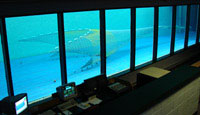Flume Tank
 Flume Tank
Flume Tank
Contact Facility Operator(s) :
Centre for Sustainable Aquatic Resources (CSAR)
Centre for Sustainable Aquatic Resources
Facility Location : Ridge Road campus, St. John's
The Marine Institute is home to the world’s largest flume tank. This facility is used to carry out performance evaluations, gear tests and other observations on newly developed or existing fishing gears and other related equipment in simulated underwater and near surface conditions. Constructed at a cost of $8.5 million CAD and first opened in 1988, the Marine Institute flume tank provides the physical environment required to:
- carry out performance evaluations, gear tests and other observations on newly developed or existing fishing gears and other related equipment in simulated underwater and near surface conditions
- provide technical services for fishermen, fishing equipment manufacturers/suppliers, other fishing industry groups and public and private organizations
- demonstrate the operations and behaviour of fixed and mobile fishing gear in water to members of the fishing industry and the general public
Dimensions: The test section is 8 metres wide x 4 metres deep x 22.25 metres long (the water level may be changed from 4m to 3m depth). These dimensions make the tank the largest flume tank of its type in the world.
The viewing gallery is able to accommodate approximately 150 people and faces a 20 metre x 3 metre observation window looking into the side of the flume tank's test section.
The flume tank contains 1.7 million litres of water when full.
Tank is divided horizontally into two sections. The lower section allows water to circulate. The upper test section holds the gear and allows observation from above and from one side.
The sides are made of reinforced concrete, except for the viewing side, which is acrylic.
Three pumps or impellers located in the return section circulate the water around the tank. Each impeller or pump is driven by a 125 HP DC motor. During circulation water passes through a flow straightening device in the lower section which takes out the swirl. The water flows along to the first set of turning vanes, up into the test section and passes through an additional screen which produces a more uniform water flow.
- 0-1 metre per second
- Typically equivalent to: 6 knots at 1:10 scale, i.e. 3 m/s
- 2 knots at full scale, i.e. 1 m/s
Produced by screens, vanes, a deflector and a wave damper.
Can move at same speed as water, at a selected speed, or remain stationary.
- Simulating seabed for bottom trawls
- Eliminating eddies caused by fluid friction against a stationary surface
Flume Tank Control: Water speed, belt speed and towing mast position are controlled through the use of a control computer and two Programmable Logic Controllers (PLC). One PLC is used to control the operation of the towing mast. Another is used to control water speed and belt speed.
A 32-channel, high-speed, data-acquisition system is used to collect drag forces from the object under test. A number of load cells are available for underwater use with ranges from 2 kilograms to 45 kilograms.




